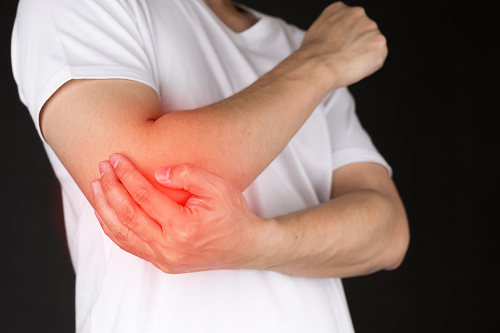Tennis Elbow
Tennis elbow, medically known as lateral epicondylitis, is a common condition that causes pain and inflammation in the outer part of the elbow. Despite its name, tennis elbow is not limited to tennis players; it can affect anyone who performs repetitive arm and wrist movements, especially those that involve gripping and twisting motions.
Tennis elbow, medically known as lateral epicondylitis, is a common overuse injury that affects the tendons in the forearm, specifically the tendons that attach to the lateral (outer) side of the elbow. Despite its name, tennis elbow is not limited to tennis players and can occur in anyone who performs repetitive arm and wrist movements.

Causes
Common activities and factors
Playing Tennis: The repetitive swinging motion, especially backhand strokes, can strain the forearm muscles and lead to tennis elbow. However, this condition is not limited to tennis players.
Manual Labor: Occupations or hobbies that involve repetitive gripping, lifting, or twisting motions, such as carpentry, plumbing, gardening, or painting, can increase the risk of developing tennis elbow.
Age: While tennis elbow can affect people of all ages, it is more common in individuals between the ages of 30 and 50.
Symptoms
The primary symptom of tennis elbow is pain and tenderness on the outer part of the elbow. This pain may gradually worsen over time and may radiate down the forearm. Other common symptoms include:
Weakness: Grip strength may decrease, making it difficult to perform everyday tasks that involve gripping objects.
Stiffness: The elbow may feel stiff and painful, especially in the morning or after periods of rest.
Pain with Activities: Pain often worsens with activities that involve gripping, lifting, or twisting motions, such as shaking hands, turning a doorknob, or holding a racket.
Treatment
Treatment for tennis elbow typically focuses on relieving pain, reducing inflammation, and promoting healing. Some common approaches include:
Rest: Avoid activities that exacerbate the symptoms to allow the affected tendons to heal.
Ice: Applying ice to the affected area can help reduce inflammation and relieve pain.
Physical Therapy: Specific exercises can help strengthen the forearm muscles and improve flexibility.
Bracing or Splinting: Wearing a brace or splint can reduce strain on the injured tendons.
Medications: Over-the-counter pain relievers and anti-inflammatory drugs may be recommended.
Corticosteroid Injections: In some cases, a healthcare provider may administer corticosteroid injections to reduce inflammation.
Extracorporeal Shock Wave Therapy (ESWT): ESWT is a non-invasive procedure that uses shock waves to stimulate healing in the affected area.
Surgery: In severe cases where conservative treatments are ineffective, surgical intervention may be considered to remove damaged tissue or reattach tendons.
